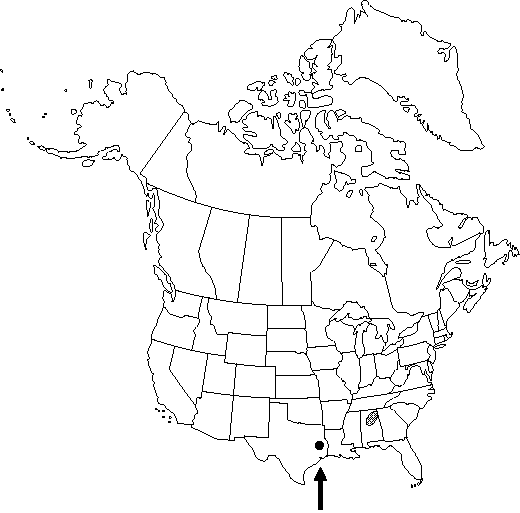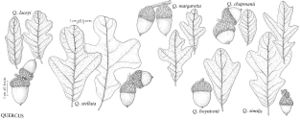Quercus boyntonii
Biltmore Bot. Stud. 1: 47. 1901.
Shrubs, rarely small trees, deciduous or subevergreen, shrubs low, under 2 m, often trailing, rhizomatous, trees to 6 m. Bark brown, scaly. Twigs light brown, 1.5-3 mm diam., densely tomentulose. Buds reddish brown, ovoid, 2-3(-4) mm, apex acute or rounded, sparsely pubescent. Leaves: petiole (4-)5-10(-15) mm. Leaf blade obovate or oblanceolate, (39-)50-100(-125) × 20-60(-91) mm, base cuneate, margins minutely revolute, broadly 3-lobed distally or with 3-5 rounded, irregular lobes in distal 1/2, secondary veins curved, 6-8 on each side, apex broadly ovate or triangular-lobed; surfaces abaxially grayish or silvery, densely tomentulose-glandular with minute, appressed-stellate hairs, adaxially dark green, glossy, glabrous or with minute, scattered, simple hairs. Acorns 1-2, on peduncle 2-10(-35) mm; cup deeply or shallowly cup-shaped, 5-10 mm deep × 10-13 mm wide, including 1/3-1/2 nut, scales closely appressed, gray, tomentulose; nut light brown, ovoid, 10-17 × 7-13 mm, apex rounded, glabrous. Cotyledons distinct.
Phenology: Flowering spring.
Habitat: Deep sands and crevices in pine forests, along streams
Elevation: 0-200 m
Distribution

Ala., Tex.
Discussion
Of conservation concern.
Quercus boyntonii is a rare and poorly known species of somewhat uncertain distribution; probably it is often overlooked. Some intermediates between Q. boyntonii and Q. margaretta are known. These tend to be larger shrubs, to 2 m with felty hairs proximally but with the rhizomatous habit of Q. boyntonii.
